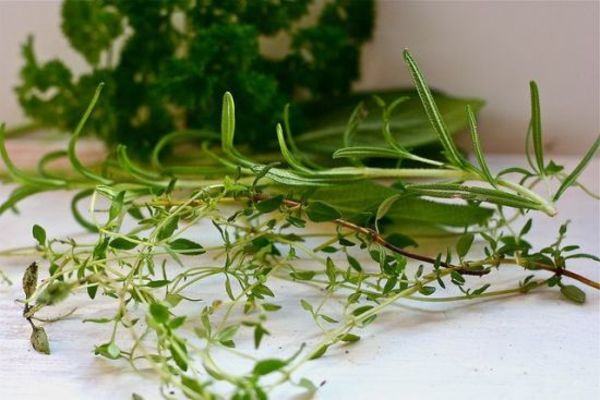When our recipes call for fresh herbs, it’s usually just the leaves that are used. Whether cooking up rosemary pork, parsley tabbouleh, or cilantro curry sauce, the leaves go into the recipe, while the stems and sprigs don’t. Even though they’re usually the most flavorful part of the herb, they are also the woodiest and thickest—so they often get tossed in the garbage or compost bin rather than the stew pot. Rather than throw out those perfectly good herb sprigs, check out these four ways to cook with them at home. You’ll never toss out a bundle of sprigs ad stems again!
Sprigs are the most flavorful part of most herbs, as they contain the highest concentration of volatile oils. The term volatile is a good thing here; it means ultra-potent. Just as the peels of oranges and lemons contain more flavor than the citrus flesh itself, the same goes for herbs. So by saving your herb sprigs, you’re not only reducing waste, you’re actually saving up some pretty flavorful stuff for your recipes. Save sprigs by keeping them loosely bundled in bags in the fridge, or keep them in the freezer for long-term storage (one to several months).
1) Use them in a bouquet garni.
A bouquet garni, literally “garnished bouquet,” is a French culinary technique of bundling up herbs and aromatics for using in soups, stocks and stews. Traditionally, a bouquet garni is a combination of parsley, thyme and a Bay leaf, and the mixture is tied with kitchen twine and simmered in your cooking liquid. You can bundle any combination of herb sprigs together, though; rosemary, cilantro, basil, whatever it is you’ve got. Bundle up your sprigs with twine or in cheesecloth, and simmer it in your fave recipes for a delectable aromatic finish.
2) Use them for kitchen infusions.
It’s outrageously simple to make gourmet infusions right in your own kitchen, with literally no effort at all. Infuse olive oils, vinegars and liquors with your leftover herb sprigs. Simply add your sprigs to the bottle of your liquid, seal and allow to infuse for a few days up to a few weeks. Strain and keep your infusion refrigerated for a couple of months.
3) Use them in a fresh pesto sauce.
Although herb sprigs are too tough and stringy to eat as they are, they puree rather smoothly in thick sauces. Save up your leafy sprigs (from cilantro, parsley, basil or mint) and use those in your next batch of pesto. Just give the food processor a few extra minutes to fully break down the sprigs.
4) Use them in sun-brewed teas.
It’s spring, folks, and there’s no reason to brew tea with hot water. Simply place your tea bags or loose leaf tea in a glass mason jar, fill with water, and allow to brew in the sun for a few hours. There’s something inherently special about “sun-kissed” tea; while there’s no scientific proof to the matter, it always tastes superior to me than any traditionally-brewed tea. Kick up your iced teas by adding herb sprigs to the jar as it steeps. A bit of natural herbal infusion for your iced green tea, plus a drizzle of honey, and you’ll be drinking pure sunshine.
Image adapted from katerha, Flickr, Creative Commons 2.0

